
MAY CONTAIN NUTS

Search Shorpy
SHORPY ART

Framed or unframed, desk size to sofa size, printed by us in Arizona and Alabama since 2007. Explore now.
Join and Share
Ad-Free Shorpy
Shorpy is funded by you. Patreon contributors get an ad-free experience.
Learn more.

Recent comments
- Illuminate us
- I remember it well
- I can't prove it
- Complicated then, forgotten now
- Bryan-Stevenson
- Skinny is as skinny does
- How do you rest in peace
- Riding the footboards
- Alas, hidden from view
- Baldwin Diesels
- Exclusive pump
- Bananas, Oysters and Smokey Joe
- Details, Details
- What's that building to the left of the tower?
- Coal Barges
- Bromo-Seltzer
- Inner harbor
- The Basin
- What a headache!
- Giant stepladder?
- Yeah, it was cold
- Love those coats
- Link & Pin Days Remnant
- Baldwin 62303
- Baldwin VO-1000
- Cold
- No expense spared
- Tough Guys
- What's your hurry, where's your hat?
- Sheriff's Signature
Member Photos
The Shorpy
Print Emporium
Print Emporium
Search Shorpy
Search results -- 30 results per page
- Wheat Spouts: 1941
- ... Superior, Wisconsin." Medium format acetate negative by John Vachon for the Farm Security Administration. View full size.
Smokin on ... Posted by Dave - 03/09/2020 - 11:59am -
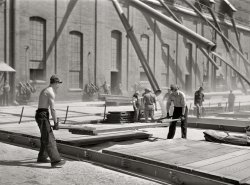
- Aerial Omaha: 1938
- ... Nebraska." Gateway to the West. Medium format negative by John Vachon for the Farm Security Administration. View full size.
Fans ... Posted by Dave - 09/14/2017 - 9:05pm -
![Aerial Omaha: 1938 UPDATE: Our vantage point for this view north along 14th Street is the Woodmen of the World tower at 1323 Farnam.
November 1938. "Omaha, Nebraska." Gateway to the West. Medium format negative by John Vachon for the Farm Security Administration. View full size.
FansAnyone aware of what the contraption is on top of the building on the left. I see fan units. Was this an air conditioning system? If so it is very narrow.
Three Corner TavernsInteresting to note the small corner taverns in the Omaha photographs: in the “Omaha Suds” image, in the Theodore's Place image, and the Oaks Tavern in this image. Three corner taverns, each about the same size and height, although some more decorated than the other. I wonder how many others existed?
Across the street is the Paris Bar and Billiards. Oaks and Paris advertised together.
What Depression?For a small city during the worst of the later Depression years, this photo portrays an impressive proportion of late model vehicles. As opposed to the trucks, the great majority of the cars seen here are within 3 or 4 years of age if not newer -- a mix probably not excelled in most U.S. localities today.
Brand new Ford TudorThe car almost directly in front of the "Nebraska" is a new 1938 Standard Ford V8. I've had one of these since the late 1970's. Once considered the ugly duckling of the 30's by almost everyone is now kinda good looking. Kinda.
Scorch marksSo what was the commercial establishment that burned at the corner of 14th and Capitol? Whatever it might have been, the fire appears to have thoroughly gutted the place.
Pay no attentionI'm assuming that this picture was taken from an airplane, so it's interesting that none of the many people on the street are looking up at the photographer. It seems like an airplane flying low over the downtown area would attract a lot of attention!
[The photo was taken from the Woodmen of the World building at 1323 Farnam Street. - Dave]
Gateway to the WestJust a minute, that nickname belongs to my native city, Winnipeg, Manitoba. But wait, Wikipedia points out that it also refers to no fewer than 6 cities in the US (Fargo, Fort Wayne, Omaha, St. Louis and the Gateway Arch, Kansas City, Pittsburgh) and one whole state (Oklahoma, although particularly Tulsa).
Location, Location, Location?I believe this photo was taken from a building on the southeast corner of 14th and Farnam. In an aerial photo from the early 1950s I can see a tall building located at that corner.
Furthermore, in that aerial photo I can clearly see the Hotel Fontenelle a few blocks to the west at 1806 Douglas and I can positively identify the fronts of the buildings in the 1300 block of Douglas where Palace Billiards and the Oaks Bar were.
[You are correct about the location (my first guess, the Hotel Fontenelle, is on the wrong block). Which means our vantage point is the 19-story Woodmen of the World headquarters, at the time of its completion in 1912 the tallest building between Chicago and the West Coast. - Dave]
No Apartments AvailableThe three story brick building being demolished was an apartment building offered for sale in January 1937. Directly across the street from it was the “Hummel Auto Shed” and the Omaha World Herald delivery truck garage and parking lot and the vacant space diagonally across the street was the site of the Jefferson Hotel, demolished in 1935.
Win some, lose someBetween the Oaks Bar and the Nebraska theater is a campaign office with banners for 19938 candidacies of (James T.) English for (Douglas) County Attorney, and (Frank) McGrath for (Douglas County) Clerk of Court. English won, and later became a state-court judge. McGrath, an incumbent mired in scandals, lost.
(The Gallery, John Vachon, Omaha, Railroads)](https://www.shorpy.com/files/images/SHORPY-8b14207a.thumbnail.jpg)
- Foot Traffic: 1941
- ... yard." The street last seen here . Acetate negative by John Vachon for the Farm Security Administration. View full size.
I'm ... Posted by Dave - 01/10/2020 - 5:04pm -
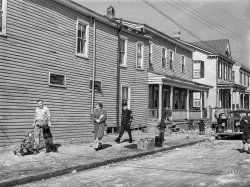
- Kroger Depot: 1941
- ... Pennsylvania." Medium format acetate negative by John Vachon for the Farm Security Administration. View full size.
In the ... Posted by Dave - 09/03/2020 - 3:33pm -
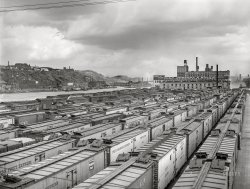
- Leo and Benny's: 1943
- ... cleaner on Washington Street." Medium format negative by John Vachon for the Office of War Information. View full size.
Nineteen ... Posted by Dave - 01/27/2013 - 11:42am -
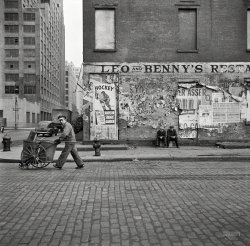
- Love Before Breakfast: 1936
- ... than Vaudeville.
further reading An article by John Tagg in the January 2003 edition of Narrative discusses this photo, also doubled evidently by FSA archivist/photographer John Vachon, in depth. I got that article on J-Stor searching "billboards."
... Posted by Dave - 08/20/2012 - 1:06am -
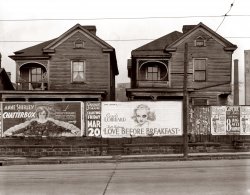
- Ironed Out: 1941
- ... at FSA trailer camp. Erie, Pennsylvania." Photo by John Vachon for the Farm Security Administration. View full size.
... carefree moments. Life is too short.
(The Gallery, John Vachon, WW2) ... Posted by Dave - 01/06/2020 - 9:13pm -
![Ironed Out: 1941 June 1941. "Wife of defense worker ironing clothes in utility building at FSA trailer camp. Erie, Pennsylvania." Photo by John Vachon for the Farm Security Administration. View full size.
High-impedance air gapThat iron would probably work a little better if it were plugged in.
[On old electric irons without an off switch or rheostat, you regulate the temperature by unplugging it. - Dave]
Where's the brown paper bag?Like my mom used to do to get the perfect crease in a pair of my Dad's RAF pants. Worked every time. Split bag seams, open flat, place on top of pants leg, iron.
I also loved the smell. And she never once burned the paper.
Ironing - not so different in 2020Much has changed since the days of the icebox and the streetcar, running boards and tube radios. But ironing still involves standing at the ironing board and drawing hot metal across wrinkled fabric.
Sure, today's so-called no-iron clothes need less ironing than this lady's cotton, but great grandma would know exactly what to do.
Let's iron this outI own an ironing board and a couple of irons. However, someplace hot is going to freeze over before I again voluntarily employ any of these objects.
That's because a couple of years ago, after ironing piles of my husband's 36-inch-sleeve white shirts (at that time he used six per week) for approximately 37 years, standing in front of the TV trying to pretend I was distracted enough by an old movie not to care that my back and legs were killing me after the third shirt, one fine day I said NO MORE. He now takes his shirts to the cleaners. If something I own needs freshening, I use a handheld steamer.
This picture makes my heart hurt for those lovely ladies, although I know they took pride in making the clothes look nice and I suspect they wouldn't want my pity. But still. I wish they could have ironed fewer clothes and had more carefree moments. Life is too short.
(The Gallery, John Vachon, WW2)](https://www.shorpy.com/files/images/SHORPY-8c19306a.thumbnail.jpg)
- Crank Call: 1940
- ... Scranton, Iowa." Medium format acetate negative by John Vachon for the Resettlement Administration. View full size.
"Turn ... Posted by Dave - 11/24/2019 - 9:15pm -
![Crank Call: 1940 April 1940. "Lady signaling operator on old-style telephone. Scranton, Iowa." Medium format acetate negative by John Vachon for the Resettlement Administration. View full size.
"Turn crank briskly ... "In October of 1975 I drove my 1965 Falcon from Vancouver, Canada, to San Francisco on a leisurely trip down the coast. I arrived at a road junction north of Fort Bragg, and saw a phone booth. I planned to stay with friends in San Francisco, and thought this was a good time to call and let them know of my arrival day. Upon entering the booth, I discovered the pay phone had no dial, and below it was a black box with a crank on it. There were detailed hand-written instructions on how to use it.
"Remove handset to be sure line is clear." There was no dial tone, and this was to determine if anyone else was using the party line. "Replace receiver, and turn crank briskly to signal operator." A male voice answered in Fort Bragg, and placed the call to San Francisco. The final instruction: "Turn crank briskly to clear the line". I charged the call to my Vancouver number, and when the bill came it read: "Call from North Rockport Toll Station No. 1."
Vancouver was one of the last large cities to convert to dial phones, a 20 year process finally completed in 1960.
A visit to New Zealand in 1985 revealed that some small towns still had not received dial telephones, as shown in this photo of a pay phone in Taihape.
I have the wheat pastebut could you bring the brushes and seam roller when you come over to help hang the wallpaper today? I have to burn some incense in the Buddha to cover up the smell from Bob's fish dinner.
Just When You ThinkIt could it get any better? Dave comes up with this caption!!! Now I have to add THIS ONE to my all time favourites list.
[Thank you! Although "Crank Call" is the title, not the caption. The caption is the writing under the photo. - Dave]
[Right! My old brain needs to reboot :) - Baxado ]
Roll CallShe has rolls of something in bundles and it seems she's calling the person she prepared them for to say they are ready. Perhaps she is making some side money. What are they?
Corner shelfI made one in wood shop class identical to that one in junior high school around 1977.
Calling up CatfishMy grandfather (b. 1898) had the innards of one of those telephones in a bucket in his fishing boat. When he was hungry for catfish, he'd load me up and we'd go out to a deep bend on the Clear Fork of the Brazos and slide the jonboat through the reeds and into the river a couple hundred feet upstream of the bend.
On one of the copper telephone wires he had tied a horseshoe as a weight, which he dropped straight down off the side of the boat. The other, much longer wire was tied to a big iron washer -- about the size of a #10 can lid. I'd paddle down to the deepest hole in the river and he would swing the washer over his head like a lasso and toss it as far as he could. As soon as the washer hit the water, he'd holler "crank it!" and I'd wind the magneto as fast as I could, creating a current between the two poles and stunning any catfish caught in between them. After a few seconds he'd get the dipnet and scoop up any electroshocked fish and we'd repeat until he had enough for a fish fry.
I later discovered this was regarded as unsporting and possibly illegal means of harvesting fishflesh. In the mid-'60s, however, I never passed up and opportunity to go "call up some catfish".
Where's the bird?She looks a lot like Granny from the Tweetie and Sylvester cartoon.
Makes me think of Bryant Pond, MaineBryant Pond was the last community in the U.S. to have crank telephones, switching over to plain vanilla dial phones in 1983.
To call my friend in Bryant Pond, I had to dial 0 and ask the operator (remember operators?) to place a call to Bryant Pond 32 -- which was my friend's number. Some operators took it in stride; others took some convincing.
Oh, my aching backI'm pretty sure her phone calls never lasted long - look at the posture she has to assume. That table makes her stand about two feet away from the phone and then lean forward over the table to get close to the mouth piece. I'm surprised I don't see a hand mark on the wallpaper from bracing oneself. And of course she'd never just clear that table and sit on top of it.
She doesn't look BuddhistSeriously, I am a little surprised by the Buddha figure on her shelf. Grandma was practicing way before it was hip!
About those rollsI'm probably wrong but, those rolls seem to me to be too narrow. Is it possible that they are player piano rolls? A couple of them seem to have narrow wooden slats along one edge. I remember seeing player pianos in one of my aunt's homes when I was a kid in the early 1950s and they generally looked like these, but were usually stored in boxes.
No hands voice dialingThat phone used no hands voice dialing, an amazing technology that is virtually unavailable today.
More!A person can never have too much wallpaper. Well, maybe sometimes.
BuddhaMy grandmother had one -- an incense burner, in green-red-gold.
Isn't It Obvious?Those rolls next to her can't be anything but more wallpaper that needs hanging!
I really like the woodworking on that fern table in front of her!
(Technology, The Gallery, John Vachon)](https://www.shorpy.com/files/images/SHORPY-8c17214a.thumbnail.jpg)
- Drink Gluek: 1940
- ... Gluek's and Grain Belt on tap. 35mm nitrate negative by John Vachon. View full size.
Still standing All that remain of Gluek's ... Posted by Dave - 01/05/2013 - 12:42pm -
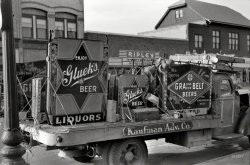
- Genoa Jalopy: 1940
- ... in Nevada.
(The Gallery, Cars, Trucks, Buses, John Vachon, Small Towns) ... Posted by Dave - 10/12/2017 - 8:39am -
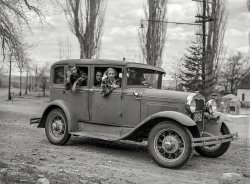
- Hello Trouble: 1937
- ... D.C. View full size. 35mm nitrate negative by John Vachon for the FSA.
Confectionery ads Love the ads on the lower front of ... Posted by Dave - 07/22/2011 - 1:42pm -
![Hello Trouble: 1937 December 1937. Midcity Cinema at 1223 Ninth Street NW in Washington, D.C. View full size. 35mm nitrate negative by John Vachon for the FSA.
Confectionery adsLove the ads on the lower front of the store "Welcome Students Get A Lift With A Camel".
I had forgotten about the movie stills. Our local theater placed the big advertising poster in a display behind glass and had the movie stills in small frames all around it at one end of the lobby. If I remember correctly, they were also in frames seen from the outside of the theater too. All those beautiful brass fixtures, chandeliers hanging from the ceiling, crystal drop sconces on the walls that dimmed slowly as the movie started, velvet wallpaper, all gone now.
Sign in the WindowS.H. Dudley, Promoter and Producer.
King's Beauty ParlorKing's Beauty Parlor offers the Poro System of beauty treatment, which, though now mostly forgotten, was probably the most significant and socially important factor in the assertion of Afro-American women's self-esteem in the first half of the 20th century. See the Answers.com bio for Annie Turnbo Malone.
At the MoviesA rather curious mix of pictures at the Midcity. They're showing a double feature of two movies made five years apart. The main feature is "Easy Living" which was released on July 7, 1937. It starred Edward Arnold, Jean Arthur and a young Ray Milland, and was written by the great Preston Sturges. The second feature is the real puzzler. According to IMDB, Charles "Buck" Jones made "Hello Trouble" back in 1932. In fact it was release July 15th 1932 meaning it was a week shy of being exactly five years older than "Easy Living." Also visible but nowhere near as prominent is a poster for a serial "The Black Coin". Even it was newer than "Hello Trouble." having been released September 1, 1936. A line-up that would seem to indicate at best a second run house.
The cast of "The Black Coin" is sort of interesting. It included a couple of really major silent movie stars - comedian Snub Pollard and Clara Kimball Young - as well as the legendary stunt man and stunt coordinator Yakima Canutt. Canutt was the second unit director who directed the chariot race scene (among others) in the 1960 remake of "Ben Hur." Also in the cast were Dave O' Brien, who would go on to win an Emmy as a writer for Red Skelton, and Ruth Mix, the daughter of legendary cowboy star Tom Mix, in what would turn out to be her final movie.
As for Buck Jones, he is considered to be one of the greatest of the "B" movie western actors. He made 57 more movies in the ten years between "Hello Trouble" and his death in 1942 in Boston's Coconut Grove Fire (November 30, 1942).
Washington D.C.?Why was the Farm Security Administration taking photos in D.C.?
I can understand that the govenment might need images of small town and rural American but this was just a few blocks away.
Lobby stillsThose movie stills - which incidentally were almost always displayed in glass-fronted cases outside cinemas in the U.K. - were never actual prints taken from the movie footage. They were specially taken on-set by a studio stills photographer shooting with a 5 x 4 camera from more or less the movie camera position. As a result sometimes, though not often, they showed angles and even set-ups that didn’t appear in the movie itself.
Midcity CinemaA chunk of ceiling and chandelier fell on audience in 1945: http://cinematreasures.org/theater/23359/
[Thank you. Now we know the address, which I added to the caption. - Dave]
Midcity CinemaThis location is now Washington Convention Center.
Mid City AddressTthe address of the Mid City was probably 1223 7th St.
During our research on the address of the Alamo, the most reliable source of info was the website about the Shaw District of Washington DC where the theaters were located:
http://planning.dc.gov/planning/lib/planning/preservation/brochures/hist...
This document mentions the address of the Mid City Theater twice on p. 14, including a reference to the theater's owner:
"As early as 1907, Shaw residents could enjoy a vaudeville act or be treated to the new technology of a moving picture show in their own neighborhood. The Happyland, Gem, Alamo, Mid-City, and Broadway Theaters were all built between 1907 and 1921 within five blocks of each other on 7th Street; the Raphael was two blocks over on 9th Street.
Of these, the Broadway and Mid-City were owned and operated by African Americans for the largely black patronage in Shaw by this time. In 1919, well-known vaudeville performer Sherman Dudley advertised his Mid-City as “the only theater on Seventh Street catering to colored people that does not discriminate.”
Colleen
(The Gallery, D.C., John Vachon, Movies)](https://www.shorpy.com/files/images/8a02974u.thumbnail.jpg)
- The Old Paxton Place: 1938
- ... Omaha, Nebraska." Medium format acetate negative by John Vachon for the Farm Security Administration. View full size.
2556 ... Posted by Dave - 08/08/2020 - 6:44pm -
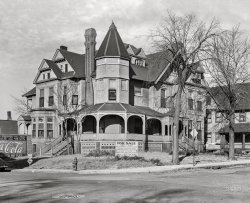
- Clean Plate Club: 1943
- ... drivers at a coffee stop on U.S. Highway 90." Photo by John Vachon, Office of War Information. View full size.
Nickel bets Don't ... Posted by Dave - 09/01/2017 - 5:49pm -
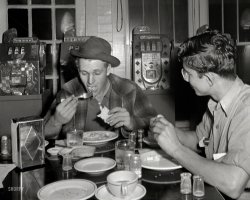
- Hitler's Children: 1943
- ... matters, especially if you're Xavier Cugat. Photo by John Vachon. View full size.
Right in the district It's not surprising ... Posted by Dave - 03/20/2013 - 5:00pm -
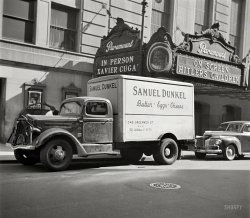
- Walnut & Fourth: 1940
- ... is all it says here. Medium format acetate negative by John Vachon for the Resettlement Administration. View full size.
Modes of ... Posted by Dave - 12/03/2019 - 4:02pm -
![Walnut & Fourth: 1940 April 1940. "Des Moines, Iowa" is all it says here. Medium format acetate negative by John Vachon for the Resettlement Administration. View full size.
Modes of DeliveryI can't stop looking at the delivery van that is turning the corner. That doesn't seem to be a common design but looks very similar on top to the modern UPS trucks with the skylights in the back.
Having walked the streets of Des Moines on many lunch hours I have come across bits of railroad track protruding from the ground where the asphalt has crumbled in the winter. This is the first picture that I have seen of those very tracks.
Additionally, I keep a Des Moines Railway Co. fare token in my pocket that my grandmother gave me. I thought it was such a neat piece of the past and I'm glad to finally see a picture of those services in action. Attached is a picture of that very token.
Streetcars and "Curbliners"While there is evidence in this photo that tracks are being removed, streetcars ran for another 11 years in Des Moines. They were replaced with electric trolleybuses (example below) uniquely named "Curbliners" in a contest; they lasted until the mid-1960s. Des Moines has an interesting history in urban transportation that you can check out here.
Mr. Sole Must Be Lonely In this highly automobile-populated photo that includes a Buick dealership, it seems odd that (beyond the dealership premises) there is nary a Buick to be seen except for the 10-year-old sedan in the oncoming lane near the fire hydrant.
[It was Des Moines' Sole Buick. - Dave]
Hotel RowWhen completed in 1930 the new 12-story Kirkwood Hotel (left) became Des Moines' third "skyscraper hotel," in addition to the two 11-story 1919 additions, the Hotel Fort Des Moines to the west and the Hotel Savery (top center). The Kirkwood, where I had lunch with the federal judge for whom I clerked every day he sat in Des Moines, remains but has been converted to apartments. The Savery has reopened as a chain hotel after a long renovation.
The office building between the Kirkwood and Savery hotels is 1916's Valley National Bank building, which was imploded in March 1981 and replaced by Capital Square.
Memories of a time I never knewMy parents were both in Des Moines as students in 1940. They met the following year, and were married in December of 1942; my dad was then in the Army and headed overseas. They both remembered their years in Des Moines fondly, and it makes me happy to think that they were somewhere close by on the very day this photo was taken.
Progress is coming.There is an extra wire for Curbliners, but only over the track with the trolley car, not in the other direction.
(The Gallery, Cars, Trucks, Buses, Gas Stations, John Vachon, Streetcars)](https://www.shorpy.com/files/images/SHORPY-8c17450a.thumbnail.jpg)
- Dakota Station: 1940
- ... Aberdeen, South Dakota." Medium format acetate negative by John Vachon for the Farm Security Administration. View full size.
Correction ... Posted by Dave - 12/18/2019 - 8:31pm -
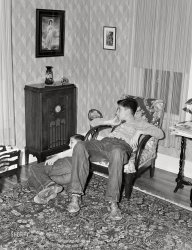
- Berrien Bunkhouse: 1940
- ... only unmarried Negroes." Medium format acetate negative by John Vachon for the Farm Security Administration. View full size.
Not the ... Posted by Dave - 06/19/2020 - 9:34am -
![Berrien Bunkhouse: 1940 July 1940. Berrien County, Michigan. "Old barn used as bunkhouse for migrant fruit pickers from the South. This grower employs only unmarried Negroes." Medium format acetate negative by John Vachon for the Farm Security Administration. View full size.
Not the HiltonBut better accommodations by far than those endured by the man with his sons and (I assume) his wife, living and sleeping in the back of a truck. But what is that black hairy-looking stuff on the walls?
Soot WebsThose webs are actually caused by charged particles of debris floating in the air that are leftover from whatever they have been cooking on the stove. This is common to see in homes that have had a fire loss or you can find them in the homes of heavy smokers.
They look creepy but it's just science doing its thing. Consider this a benefit of fire and mold remediation classes. The sad thing is, in a fire loss, clean-up companies and claims adjustors have to continually let distraught insureds know that it's not because they didn't keep their house clean, but because of the smoke that was present in the fire.
Here's one of many resources put out by ServPro that explain this phenomenon: https://www.servproofnortheastwichita.com/blog/post/100600/fire-smoke-da...
Tangled websI believe the "black hairy-looking stuff" JennyPennifer inquired about is an accumulation of soot-covered cobwebs. The major cause of the soot, of course, is visible at right.
At least they'll stay warmYes, these are better accommodations than were provided for a lot of the migrant families we've seen on Shorpy. They even have a stove. So I wonder, was it easier for the unmarried migrant workers to get the best paying jobs with the better housing? Although the poor gentleman in the polka-dot socks is in desperate need of a new pair of shoes.
[Wives and kids require extra housing. Hence the preference for bachelors. - Dave]
Much we still don't knowI question Tamara's statement that these bachelors obtained the best paying jobs for this work. They were also selected because they were negroes. From what I know about 1940s America, a negro work crew would have been paid less than a white one … or charged more for lodging, food, etc.
I understand migrant workers with families have less personal time to devote to themselves. Still, I am struck by how well groomed are these four men. Each one is clean shaved, except the one mustache, which is neatly trimmed. Their hair is neatly cut. Maybe they helped one another keep groomed?
Well groomedThey work hard during the day but still have hopes of getting lucky at the nightly dances! They need to look nice.
(The Gallery, Agriculture, John Vachon)](https://www.shorpy.com/files/images/SHORPY-8c17667a1.thumbnail.jpg)
- Pit Stop: 1940
- ... County, Michigan." Medium format acetate negative by John Vachon for the Farm Security Administration. View full size.
The ... Posted by Dave - 03/01/2018 - 7:37pm -
![Pit Stop: 1940 July 1940. "Migrant fruit workers from Louisiana fixing flat tire along the road. Berrien County, Michigan." Medium format acetate negative by John Vachon for the Farm Security Administration. View full size.
The problem is deeperIf it were just a flat tire, why would he need to touch the wheel hub?
Safety First...or as Mike Rowe from "Dirty Jobs" would say, "It's at least in the Top 10 there somewhere!" I'm glad they have that rock blocking the front wheel to keep that Ford from rolling away. It also looks like they'll be doing this again on down the road. Those tires appear to be the "Maypop" brand. You know, as in "they may POP at any time!"
Brake/break job.This Model A Ford is in decent shape having lost a few items over the years such as horn, center bumper clamp, license plate clamps. Note the license plate was digging into the radiator, so it was moved to the side. The wheels are from a 1930-1931 Ford. This example is the 1928-1929 type, a Tudor in Ford parlance.
Expensive tripLooks like they had to replace the front right tire outright already on this trip. Others look like they're getting their money's worth.
Berrien County is still a good fruit growing region--I grew up going downstairs almost every night for a mason jar of fruit my mom had canned after buying it for a very reasonable price. They're even getting some decent wineries after moving away from growing Concord grapes for bum wines for a long time.
The JobI picked cherries in MI as a kid in the mid 50s. If nothing changed, they make you pick the whole tree (not just the easy cherries), and punched a ticket for every full bucket you gave them.
The punches turned into money when you turned in the ticket.
You could eat as many cherries as you wanted. This didn't turn out to be as many as you might think.
And more to fixlooks like someone lost the little wire clips that hold the headlight lenses in place last time they got new bulbs! With the randomly oriented lenses, they are probably seeing only treetops and wandering possums at night.
A remarkable number of Shorpy migrant and depression era pictures include '28-9 Fords -- they were the national standard for cheap and reliable used cars.
[Also MIA: the passenger-side headlamp visor. - Dave]
The George McFly lightBack when sealed-beam headlamps were secured by two adjusting screws and one strong spring (that is to say, only three decades ago), I used to joke that if you lost the spring, and the headlamp pointed into the treetops, you could spot Marty McFly's dad in time to stop.
Safety rule , avoid pinch pointsI hope that vehicle was blocked up securely and not just held up by a jack . They have a rock under the front right tire to stop forward motion. But judging from the tension on his forearms he's pulling hard on the hub or brake assembly . The rock is not going prevent sideways movement . This is while exposing his legs which are under the vehicle .
No need to remove the wheelOn the Model A (and probably other cars of the period) could change tires or repair tubes without removing the wheel. I've done it a few times.
Joke's on RussiaThe Russian government showed their people the movie "The Grapes of Wrath" so they could see how bad things were in America. Instead, the Russian people were very impressed that even poor people in America owned cars.
(The Gallery, Cars, Trucks, Buses, John Vachon, On the Road)](https://www.shorpy.com/files/images/SHORPY-8b37586a1.thumbnail.jpg)
- Hop In: 1937
- ... Uncaptioned photo from a batch of 35mm negatives taken by John Vachon in the fall of 1937 in Annapolis, Maryland, and Newport News, Virginia. ... Posted by Dave - 06/06/2012 - 5:39am -
![Hop In: 1937 Uncaptioned photo from a batch of 35mm negatives taken by John Vachon in the fall of 1937 in Annapolis, Maryland, and Newport News, Virginia. The car, a Cord convertible, would be worth around a zillion bucks today. View full size.
Suped-upAh, the Cord convertible. In "Anybody Can Do Anything," a sequel to "The Egg and I," Betty MacDonald writes about the cream-colored Cord convertible her brother owned, and how the family would go for rides on weekends until they couldn't afford the gas. Then the Cord became part of an intricate series of trades that I think ended up with him acquiring a house.
I found this interesting, from Wikipedia:
Supercharging was made available on the 1937 812 model. Supercharged 812 models were distinguished from the normally aspirated 812s by the brilliant chrome-plated external exhaust pipes mounted on each side of the hood and grill. With supercharging, horsepower was raised to 170.
It was too late to save Cord, but the contraction "Suped" (referring its supercharged engine) lived on in American lexicon as the hot-rodding phrase "Suped-Up."
[To be taken with a grain of salt. The expression is "souped up" -- for which Webster's gives an entirely different derivation. - Dave]
A Gazillion Equals $75,0001937 Cord 812 Convertible
Must be that "new math"It seems that $75K only gets you the original steel body, with all mechanicals replaced with modern equipment. A complete original will go well into 7 figures. There's a nice original yellow '37 here in my hometown that I see at the post office or court house now and again, owned by a local retired grocer (who owns more than 60 cars of similar caliber).
Another pricey car I see frequently is a '37 Auburn boattail convertible used as a daily driver by a retired auto dealer. (I'd hate to see his insurance bill). Our smirking driver here is no more attractive than the grocer's daughter whom I dated in high school, with a face too high a price to pay daily for a chance to inherit even that collection.
$185kThere is a nicely restored '37 Cord Phaeton currently in Hemmings for $185k.
http://www.hemmings.com/classifieds/dealer/cord/810/1412757.html
Thought balloon"That's right, my car is better than yours."
Of course,it's not a doozy!
Tom Mix had oneA nice supercharged 37 went for 130k at last fall's auction in Hershey. I believe it was a former AACA winner from the 70's, but still a 90+ point car on the CCCA scale.
Tom Mix had one of these and it still exists and has been restored.
Front Wheel DriveOne of the most important features of this car is the front wheel drive. It is one of the few front wheel drive American cars made before WWII that were produced in any appreciable quantity (1,146 in 1937).
The Cord 812s with superchargers are even rarer (less than 200 built over two years).
Cost in 1937 was $2,560. Prices today vary depending on condition, originality, presence of a supercharger, provenance, options, etc., but expect to pay $200,000 - $275,000 for a supercharged exampled in very good condition.
InsuranceOldFogie wonders below about insurance premiums. One of my colleagues restored Studebakers. I asked him about insurance, and he said it was quite reasonable. The impression I got is that insurance companies figure collectors/restorers are good risks.
Can any of you more knowledgeable guys/gals chime in on this?
A first and a last.This car was noted for being an early front wheel drive vehicle but it was also one of the last cars to be designed entirely by one man. Gordon Buehrig was the designer's name. He was also responsible for Auburn's boat tail speedster and many other notable design concepts.
And blinking headlamps, too.Aside from the front wheel drive, another innovation is the disappearing headlamps. Geo might have a point about insurance for collectors as good risks. I pay $56 a month, full coverage, for a fleet of vintage Jaguars and one vintage Cadillac (no accidents, ever). Most I know pay far more for a single car. But I'm betting insurance on a real classic *driven as a daily driver* would be considerably higher than for one infrequently driven (a point my insurance agent checks annually with odometer readings). Quotes for my insurance varied by a factor of 20.
Timeless beauty The 810/812 series Cords replaced the disastrous L29s. Errett Lobban Cord wanted a car bearing his name. Front wheel drive. On the cheap. Thus, it was decided the straight eight Auburn motor would be used in order to save the R and D costs associated with a new engine. The result was that the normal front to rear sequence of engine, transmission and differential was simply reversed in the L29. From the front it became differential, transmission, and the very long straight eight. The car was engineered by the one and only Harry Miller, and design was under the supervision of Auburn chief designer Al Leamy. Industrial designer Brooks Stevens worked up a stunning one off L29. Functionally the cars were a disaster, as the long wheelbase put very little weight over the front drive wheels. Uphill movement, especially in the rain, became hazardous because there was so little traction. The wheels would slip, and frequently ignore any attempt at turning. The model lasted two years, I believe. By the time the beautiful Buehrig ‘coffin nose’ masterpiece came to market, engineered and designed to perfection, it was too late. The depression pretty much did the car and the Auburn, Cord Duesenberg Company in. I understand Cord was in England settled in for the long haul, as the Securities and Exchange folk wanted to talk with him. Buehrig eventually ended up at Ford, where he had a hand in designing the lovely 56 Lincoln Mark II, among other cars. It’s a rare ‘most beautiful cars ever’ list one will see that doesn’t include the Cord 810/812s. They’re timeless.
InsuranceCollector Car insurance is pretty reasonably priced (compared to the value of the vehicle). It's generally based upon very limited street usage, with severe limits to the number of miles that the car can be driven. Unfortunately, things like Cords tend to mostly be trailer queens these days, with the majority of their miles put on during tours before or after car shows. (Thus speaketh the car show judge)
Old Car InsuranceTo chime in on this subject, most collectable and antique vehicles (25 yrs. old and older) are insured by companies that specialize in this coverage. They agree on a stated value, and limit annual mileage to 2500 miles (this may vary depending on the insurer). This coverage will not allow the vehicle to be a daily driver, just what would be considered normal driving to car shows, swap meets, cruise nights, and the occasional spin around town. Because of these restrictions, the cost of insurance is very reasonable. As OldFogie noted, driving one of these classics "every day" is a different story. You would have to find a mainstream company to agree to a stated value and then pay through the nose, I'm sure!
So he was an artistRE: "Buehrig eventually ended up at Ford, where he had a hand in designing the lovely 56 Lincoln Mark II" -- interesting point I did not know. I liked that Lincoln, and only that Lincoln. It seemed rather out in left field compared to Ford's other production. His hand in it explains that anomaly.
Stars with CordsThere's a much circulated Internet photo of the happily-married Hollywood stars Joan Blondell & Dick Powell in their Cord convertible, taken about 1937 looking both glamorous & prosperous. Also, cowboy star Tom Mix met his untimely demise speeding through Arizona while driving his Cord convertible in 1940, when an unsecured heavy metal suitcase slammed into the back of his head. TM's restored car survives and was recently featured in an Antique Automobile Club magazine article.
Auburn-Cord-Duesenberg FestivalBorn in Motown, having a father that loved autos and then living in South Bend, Indiana from 1970-79 afforded my family the opportunity to visit Auburn during the Labor Day weekend "Auburn-Cord-Duesenberg Festival" in its infancy in the early 70s when I was about 10 or 11.
My dad's territory (he was a salesman for Belknap Hardware, a Louisville-based hardware wholesaler) was northern Indiana and SW Michigan and had heard through the grapevine about a classic car festival and auction at Auburn High School. We were off!
The museum is a wonderful tribute to art deco architecture and for anyone passing through Fort Wayne or with an appreciation for the classics, this is a must see. Though I would highly recommend attending during the Labor Day weekend. Studebaker was but a distant memory for South Bend even in the 70s.
We moved back to Detroit in the 80s and visited Auburn during the festival a few times since. It has grown considerably in size and attendance and a few years ago went through tough times with the auctioneer being accused of not paying sellers after their vehicles sold.
Auburn is where dad taught his daughter true appreciation for--and identification of--the classics. My favorite is indeed the Auburn Boattail Speedster!
Invitation to the pastIt's as if this lady is beckoning us to come back in time and take a ride in this classic car. The chrome is pristine, the paint glows. The leather is soft and supple. The finely tuned engine purrs with restrained power. Take a ride and relish an era before plastics and electronics rob us of the soul of the machine.
(The Gallery, Cars, Trucks, Buses, John Vachon)](https://www.shorpy.com/files/images/SHORPY_8a02921a.thumbnail.jpg)
- Tattooing & Curios: 1941
- ... Norfolk, Virginia." Medium format acetate negative by John Vachon for the Farm Security Administration. View full size.
... Posted by Dave - 06/24/2020 - 10:43am -
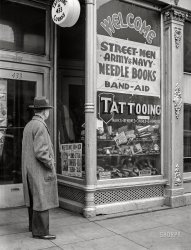
- Blinds, Frames: 1940
- ... Iowa. Sash and door mill." 35mm nitrate negative by John Vachon for the Farm Security Administration. It's a Vachon-a-rama here at ... Posted by Dave - 09/01/2010 - 8:17pm -
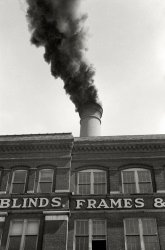
- Parochial Playground: 1940
- ... Dubuque, Iowa." Medium format acetate negative by John Vachon for the Resettlement Administration. View full size.
Ball I ... Posted by Dave - 11/27/2019 - 3:34pm -
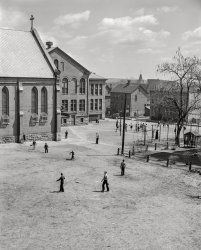
- A Drink for Baby: 1943
- ... Carolina en route to Charlotte." Medium format negative by John Vachon for the Office of War Information. View full size.
Easy Peasy ... Posted by Dave - 08/31/2017 - 7:45pm -
![A Drink for Baby: 1943 March 1943. "Melvin Cash, truck driver, putting water in his radiator along U.S. Highway 29 in North Carolina en route to Charlotte." Medium format negative by John Vachon for the Office of War Information. View full size.
Easy Peasy Nice and EasyI'll take the jacket, the hat and the water bucket. I'd take the truck too but parking could be a challenge. I love SHORPY -- it never fails to deliver.
Truck IDBrown; in house make of Associated Transport.
[The tractor is a circa 1938 Corbitt in Horton Trucking livery. Some of these were rebadged as Browns after Horton entered into the Associated Transport merger. - Dave]
Sealed beam conversion?Hayslip, looking at the size of the headlight buckets versus the headlights, I'm wondering if it has been fitted with a sealed beam conversion. One big advantage that came with the advent of sealed beams was that the lamps were a universal 7-inch size that would fit anything. It was much easier to replace the lamp after it burned out, and replacing one after taking a hit from a stone meant you didn't have to try to find parts specific to your vehicle - especially important for over-the-road trucks.
The REAL movers and shakersThis comment may seem off-topic, but I'd like to acknowledge all the truckers and railroad workers that often provided a bright spot to the day for many youngsters, me included, at least in the 1940's and 50's since we walked everywhere including to school, church, movies, the park, etc. It was such a kick for a kid to see a big rig coming down the road and know that if he just put up his arm and pretended to pull a rope, that the congenial trucker would blast on his air horn just for us. Likewise, if a train was passing by and we could see the engineer or the caboose man, they would wave and blow their whistle and make one feel important. Yes, I was a sometimes lonely, small town kid, usually walking alone everywhere, but these men made me feel like I had some influence in the world. It was a feeling of mutual respect on both sides and I salute and thank them all for taking the time to acknowledge the requests of all the powerless children everywhere who enjoyed immensely causing the instant reaction from the vehicle's operator. I know the work of truckers and railroaders is grueling and often taken for granted but they made the day for many kids and brought everything people needed to remote villages and towns across the country and they still do. Thanks guys.
(The Gallery, Cars, Trucks, Buses, John Vachon)](https://www.shorpy.com/files/images/SHORPY-8d27720a.thumbnail.jpg)
- Ready for Liftoff: 1938
- ... in Greenhills, Ohio." Medium format negative by John Vachon for the Resettlement Administration. View full size.
What a ... Posted by Dave - 08/07/2017 - 2:46pm -
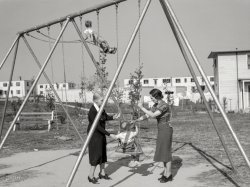
- City Terminal: 1941
- ... vegetables at city terminal." Medium format negative by John Vachon for the Farm Security Administration. View full size.
Gulf Tower ... Posted by Dave - 01/31/2020 - 9:25pm -
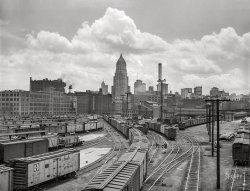
- Pies in Repose: 1940
- ... i like about this site; it reintroduces photographers like John Vachon and Jack Delano.
Reflections on a holiday Taking the photo in the ... Posted by Dave - 11/25/2010 - 7:23pm -
![Pies in Repose: 1940 November 28, 1940. "Pumpkin pies and Thanksgiving dinner at the home of Mr. Timothy Levy Crouch, a Rogerene Quaker living in Ledyard, Connecticut." Photo by Jack Delano for the Farm Security Administration. View full size.
OriginWe finally see where the origin of the fruitcake came from. Could it be the exact same one that my mother had on the table that no one ate in 1950?
The First FruitcakeI remember well the ritual of the long process of making the holiday fruitcakes from cracking nuts (in shells) to chopping candied fruit and dicing dates and finally, after it was all baked for hours, to wrapping it in brandy or rum soaked cheesecloth and storing it away in some cool spot being forbidden to cut into it before Thanksgiving. These rustic pies look and smell (I have a good imagination) incredibly tasty, and the laboriously crafted fruitcake had no idea that in less than 70 years it would become a much maligned and unwanted joke. The elderly in your audience will remember when fruitcake was a highlighted specialty of the holiday season. I understand that now they actually shoot them from cannons and use them for doorstops. As for this photo, I find it outstanding in every way, just beautiful. Thanks yet again for this warm family portrait.
Mmmmm, pieeeeI can smell them!
NeatoI love that wallpaper. I wonder what colour it was.
Ummmm, pie!The pies look delicious. I would be willing to bet those flaky crusts were made with good old lard, too. When you talk of shortening, there wasn't anything shorter than lard.
$5 on the pumpkin pie!I wonder what the folks in this wonderfully American family photo would think if they knew that 70 years later thousands of people were spending their Thanksgiving gambling at a massive casino (Foxwoods) located in the very same town?
It's the kind of wallpaper that's difficult to hangIt's interesting to analyse past family festive gatherings by the relative loudness of the patterns on the wallpaper and curtains in the background.
This kind of wallpaper is annoying to hang to get the patterns to line up.
Could we have a sequence of photos on 'wallpaper and curtain patterns through the ages'? (The 60s and 70s seem to have been particularly loud).
Family albumMore of the Crouches here.
How It Was DoneThe pie in the center front brings back memories of watching my mother finish putting together pies by holding a fork upside down and pressing the tines into the pie's rim all the way around, sealing the top to the bottom and making those tiny grooves.
OmigoodnessI have nothing clever or insightful to say, just want to express my appreciation to Shorpy for showing a slice of life gone forever. We are fortunate indeed to have these photos. The lively wallpaper and cloth speaks to a Quaker way of life I did not know existed--no "plainness" here.
"Just shut it, Tim"The centerpiece lets me pretend it's the Missus sticking the fork in his mouth.
There's something about this pictureThat is just lovely. This is what i like about this site; it reintroduces photographers like John Vachon and Jack Delano.
Reflections on a holidayTaking the photo in the mirror is a great idea.
RogerenesI had never heard of the Rogerene Quakers before, which surprised me, since I am a Quaker and have read quite a bit about Quaker history.
A little googling shows that the Rogerene Quakers had no connection to other Quaker groups, although there was some similarity in their beliefs (particularly pacifism). They also resemble Baptists and Seventh Day Adventists.
I have to say that's a lovely photo, the use of the mirror is terrific. And I would love to have a slice of that fruitcake. I don't know why they have such a bad rep. Like everything, there are good ones and bad ones, and a good one is a real treat.
Compare and contrastInteresting to contrast this family with the one in Kentucky of which we saw so much earlier in the fall. I wonder if their dessert table ever looked liked this?
The pies at my daughter's house yesterday looked just like these--courtesy of my ex-wife.
Makes me feel guiltyI only baked two pies yesterday! I wonder what kind the two-crust pies were; apple, cherry, mincemeat?
This also reminds me of a certain fruitcake my mother baked in 1967. It was kept in our extra fridge, in the utility closet. That was also where my dad's huge liquor collection resided. Mom was soaking it with bourbon every once in a while, and so was I. By Christmas that was some wonderful fruit cake! It had a lovely bourbon flavor, but didn't taste like alcohol.
I hate hearing all of the maligning of fruitcakes that takes place, now! It was just like everything else; bad ones were awful, but good ones were delicious. I would bet the one in this picture was delicious!
I like fruitcakeWe don't see very many people in this mirror view, but the impression is that there aren't that many. After all, the stove in a previous picture wasn't cooking cauldrons. So, six pies (at least), and a fruitcake? Wow. Those home-made pies were probably great, but still seems like a lot of pie.
On the Wallpaper-Mr. Plate looks sad.
Now THISis Pie Town!
The wallpaperThe wallpaper really got my attention. The house we rented from 1958-63 had a very similar print washable wallpaper in our kitchen. Given that this photo was taken in 1940, then our wallpaper might have been 20 years old (or older) at the time.
FROOTSCAKES!Let me at that fruitcake, man. Om nom nom nom nom!
No punsAbout the large family of the rogerin' Quakers? Good, because that would be rude and tasteless.
Thanksgiving 1940Thanksgiving day 1940 was November 21st, not November 28th!
[It was celebrated on two different dates that year, as well as 1939 and 1941. The New England states observed the traditional fourth Thursday in November. - Dave]
Cookery I can't speak for these dear people, but my family always coded two crust pies differently. The slits and occasional decorations on top denoted the contents. I would guess, a pumpkin, sweet potato, cherry, apple and peach. While that glorious molasses and candied fruit and nut bundt would wait for evening coffee and tea, foolishly ignored by the unsophisticated children, in favor of the sweeter and juicier fruit offerings.
FruitcakeI never liked it until I ate my mother in law's. Now, our family demands I make it every year. Usually made two at a time to begin with so one will be ready for the next year. Then every year after, one is made and stored away while the previous year's is eaten. I have to say it is the best I've ever eaten and my family agrees. Even the kids like it. Love to see pictures like this. Brings back memories of my childhood. My mother wore her hair like that and our family Thanksgiving and Christmas dinners were enormous. Lots and lots of people and food. So many, we had to eat in shifts. Such happy memories.
The Timothy Levi Crouch familyThis pictures, along with several others, were taken at my great-grandparents' Thanksgiving dinner in 1940. My grandfather, one of their sons-in-law, is the gentleman with the fork in his mouth. This collection of pictures by Jack Delano is really neat, and I love to see them posted on the internet.
There were 14 Crouch children living at the time this was taken, the youngest being about 12. There were definitely more people at the dinner than this picture would indicate, and most likely some of the other married children dropped in later in the day to enjoy pie.
For many years the family only knew of this one picture. It wasn't until the age of internet that we discovered that there were about 20 of them along with pictures taken at the one-room schoolhouse. My mother is in pictures at both locations. She remembers the photographer being at the dinner, but she doesn't recall him being at the school. It was quite the shock when I showed her all the pictures!
(The Gallery, Jack Delano, Thanksgiving)](https://www.shorpy.com/files/images/8c04161u.thumbnail.jpg)
- Rocky II: 1954
- ... be PS 19 on First Avenue, not PS 9.
(The Gallery, John Vachon, NYC, Sports) ... Posted by Dave - 08/21/2013 - 6:36pm -
![Rocky II: 1954 1954. "Boxer Rocky Graziano walking streets in New York with local boys." From photos for the Look magazine article "The Fight of My Life." View full size.
SignsThe beautiful street corner lamppost was typical throughout the New York City area, and were eventually replaced over the next two decades. I remember playing playing around lampposts such as this growing up in Queens in the 60s and 70s. The sign that reads QUIET School Drive Slowly is probably in reference to neighboring P.S. 60 with the back entrance on 11th Street, and the main entrance on 420 E12th Street.
MeatlandAnd how did Rocky and his pals get so strong?
By doing lots of shopping at "Meatland" the carnivore store behind the boxer!
Looking north on First AvenueRocky and his friends are on the southeast corner of the intersection and the view is to the north along First. Many of the buildings are still there today, though needless to say they house a more upscale array of businesses than 1954's humble neighborhood stores. The building one over the head of the man in the checkered shirt and those to its right, located on the west side of First between 11th and 12th streets, were not long for the world at the time of this picture. Public School 9, the Asher Levy Campus, opened in that location in the fall of 1955. [No, that is not a mistake; in the 1950's it was still possible for the city to build a school in a year. Times certainly have changed.]
Speaking of changes, this neighborhood has seen a few. In 1954 it was known as the Lower East Side and was mainly a working-class area. Nothing fancy, not by a long shot, but a decent place in which to raise a family on a workingman's salary. By the 1960's, however, it began a steady decline. It never quite became a slum, but was close. Just one block to the east, the Alphabet City neighborhood (along avenues A, B, C and D) became infested with drugs and gangs, and even in broad daylight could be dangerous. Starting around 25 years ago, however, the area seen here got much nicer. Today, generally known as the East Village, it probably houses more "Trustafarians" than working-class families.
It's not surprising that Graziano looked worn-out in these pictures, as another comment noted. He fought 83 times in his 10-year professional career. That would be almost unthinkable today, when a boxer who fights four times in a year is unusually busy.
Time and tideI was thinking that Rocky looked tired and out of shape in these photos, and sure enough, a web search shows his last fights in 1952. Therefore, his boxing prime was well over at this point. I remember watching him on the Martha Raye TV show where he was a regular.
In Living ColorSome buildings still there. Some delivery vans updated.
School on 1st AvenueThat would be PS 19 on First Avenue, not PS 9.
(The Gallery, John Vachon, NYC, Sports)](https://www.shorpy.com/files/images/SHORPY_23627u.thumbnail.jpg)
- Hot Wheels: 1942
- ... Better buy Buick! Medium format acetate negative by John Vachon for the Farm Security Administration. View full size.
No room at ... Posted by Dave - 02/27/2022 - 3:28pm -
![Hot Wheels: 1942 After the halt of automobile production and "freeze" of car sales, these 1942 Buicks were among the last new models the public could buy until the end of the war.
May 1942. "Grand Island, Nebraska. Auto dealer's window." Better buy Buick! Medium format acetate negative by John Vachon for the Farm Security Administration. View full size.
No room at the "N" Should've paid for larger lettering.
[Or slightly smaller! - Dave]
Brubaker Buick102 East 2nd Street is now an empty lot, but I was able to locate this memory.
If you qualifyThe Office of Production Management issued an order on Jan. 14, 1942, to "stockpile" all cars shipped after Jan. 15. Cars shipped to dealers could not be sold until specific permission to sell was granted when deemed "in the public interest" but such permission probably wasn't granted earlier than January 1943. Dealers were also required to make the tires and tubes from such vehicles available to any "appropriate agency" at any time so requested.
All manufacturers ended their production of automobiles on February 22, 1942. The January 1942 production quota had been a little over 100,000 automobiles and light trucks. The units manufactured at the beginning of February would bring up the total number of vehicles in a newly established car stockpile to 520,000. These would be available during the duration of the war for rationed sales by auto dealers to purchasers deemed “essential drivers.”
The government’s Office of Price Administration also imposed rationing of gasoline and tires and set a national speed limit of 35 mph.
During the early part of February 1942 all car owners were required to record the serial numbers of the tires on their cars and report them to the proper authorities. They also had to certify that they had only five tires and tubes for each vehicle they owned.
Still available?It took me 80 years, but I finally qualify.
Not Froze?And not Freezed either. And no snow in May.
"Frozen" was not even a Disney dream at the time, correct as the grammar might have been.
Hot cars indeed!
That car?Could it be a Buick Super? The front end looks identical to some images I found online for that year/make/model.
Assault on freedom?I am bemused by Geezer's report that in 1942 the U.S. government required everyone with a car to submit the serial numbers on their tires. Gives some perspective on the current "freedom"-defending North Americans attacking protective mask mandates.
Doleful BuickSad-eyed appearance brings to mind a forlorn and lonely pet shop animal.
Purchasing a Buick Straight Eight with city MPG in the 12-14 range and strict gasoline rationing in effect, wouldn't have appealed to the average buyer.
SharksThat Buick behind the glass - collective image of the sales force behind?
BTW, I love 40's car design.
(The Gallery, Cars, Trucks, Buses, Small Towns, WW2)](https://www.shorpy.com/files/images/SHORPY-8c22087a.thumbnail.jpg)
- Bus Start: 1936
- ... We're not at the DC Greyhound terminal photographed by John Vachon on Christmas Eve 1941, with examples on Shorpy. The earlier terminal was ... Posted by Dave - 06/30/2020 - 4:56pm -
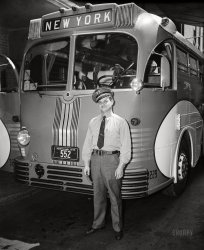
- Joy Boys: 1940
- ... to build barracks at Camp Blanding -- and the reason John Vachon was assigned to take these photos, was the War. By December 1940, a year ... Posted by Dave - 08/05/2020 - 2:22pm -
![Joy Boys: 1940 December 1940. Starke, Florida. "Soldiers Joy Cafe, newly constructed for construction workers near Camp Blanding." Acetate negative by Marion Post Wolcott. View full size.
It seems the wardid not stifle the production of beer or neon signs.
Three fellowswaiting for a novel to be written about them.
The middle guy and one on the viewer's left look like they could be related. Brothers? But the fellow in the coat and hat --
I bet they all told interesting stories when they were drunk.
Does it really get cold enough in Florida for a coat that heavy?
[Oh my yes. - Dave]
Native Floridian at a glanceStarke is in northern Florida and this image was made in December so to a native of the state the weather is very cold. To those new in town it is Florida and 60 degrees is plenty warm -- all we need are sleeves and maybe a light sweater.
It is even more obvious in South Florida when picking out Canadians versus natives at the pool in January. Canadians dive in when natives hesitate to dip a toe.
Not at war yetFor you "Ice Gang", check the date of the photo, we are not at war yet.
[The reason this bar was built -- to serve the hundreds of construction workers newly arrived to build barracks at Camp Blanding -- and the reason John Vachon was assigned to take these photos, was the War. By December 1940, a year before Pearl Harbor, America was heavily involved in the war effort. - Dave]
Macabre meaningSoldier's Joy is a 200-year-old Scottish fiddle tune that Robert Burns eventually wrote lyrics for. His version is of a veteran who is homeless and disfigured from battle, but recounts the joy of having served in the army.
During the Civil War the phrase became synonymous with morphine, as some lyrics written during that time go:
"Gimme some of that Soldier’s Joy, you know what I mean,
I don’t want to hurt no more, my leg is turnin’ green."
Fast getawayI bet there were nightly face plants from those stairs.
Best version of Soldier's Joy you'll ever hearOn the "Will the Circle Be Unbroken" album, with John McEuen ripping through the melody and Junior Huskey laying down a killer bass line.
Listen to it here:
https://www.youtube.com/watch?v=Gn76byAtQ_g
Jax also Builds Health!1940's Refrigerator - Tool Box Magnet, probably an ad design by Alberto Vargas.
The gent on the rightLooks old enough to remember the Great War, certainly too old for active duty in the current one.
A 1940 Fashion Statement?The sartorial skills in Starke are seriously lacking. But help is coming lads -- smart, fashionable and practical men's clothing will be widely available after the war.
Weekend at Joy Boy'sEither the word "JOY" isn't in the fellow on the rights vocabulary or this was the idea for the comedy movie Weekend at Bernie's, 1940 style.
Who built the bar?The building the bar is in looks like a barracks.
I'll bet at night the neon looked really cool.
Who dunnit?LOC says these Starke photos are by Marion Post Wolcott.
[Oops. Right you are! - Dave]
Joy BoysWell, OK, but the one on the right looks like a sourball. No joy with this dude.
(The Gallery, Eateries & Bars, Florida, M.P. Wolcott)](https://www.shorpy.com/files/images/SHORPY-8c14469a.thumbnail.jpg)























